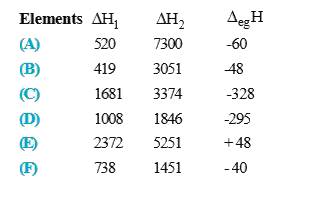The first and second ionization enthalpies and electron gain enthalpy of some elements are as given below:

The metal which can predominantly form a stable cova- lent halide of the type (MX) (X : Halogen)
(F)
(B)
(D)
(A)
The correct Answer is:D
Step by step video, text & image solution for The first and second ionization enthalpies and electron gain enthalpy of some elements are as given below: The metal which can predominantly form a stable cova- lent halide of the type (MX) (X : Halogen) by Chemistry experts to help you in doubts & scoring excellent marks in Class 12 exams.
Updated on:21/07/2023Similar Questions
Knowledge Check
The first and second ionization enthalpies and electron gain enthalpy of some elements are as given below:

A metal which can form a stable binary halide of the type MX2 is (X : Halogen)A(A)B(B)C(F)D(D)The first and second ionization enthalpies and electron gain enthalpy of some elements are as given below:

A metal which can form a stable binary halide of the type MX2 is (X : Halogen)A(A)B(B)C(F)D(D)The first and second ionization enthalpies and electron gain enthalpy of some elements are as given below:

Which of these elements is the most reactive metal?A(A)B(B)C(F)D(D)
The first (ΔiH1) and second (ΔiH2) ionisation enthalpies (inkJmol−1) and the (ΔegHө) electron gain enthalpy (inkJmol−1) of a few elements are given below:
Elements(ΔiH1)(ΔiH2)ΔegHөI5207300−60II4193051−48III16813374−328IV10081846−295V23725251+48VI7381451−40
Which of the above elements is likely to be
a. the least reactive element.
b. the most reactive metal.
c. the most reactive non-metal.
d. the least reactive non-metal.
e. the metal which can form a stable binary halide of the formula MX (X=halogen).
f. the metal which can form a predominantly stable covalent halide of the formula MX(X=halogen).
View SolutionThe first (ΔiH1) and second (ΔiH2) ionisation enthalpies (inkJmol−1) and the (ΔegHө) electron gain enthalpy (inkJmol−1) of a few elements are given below:
Elements(ΔiH1)(ΔiH2)ΔegHөI5207300−60II4193051−48III16813374−328IV10081846−295V23725251+48VI7381451−40
Which of the above elements is likely to be
a. the least reactive element.
b. the most reactive metal.
c. the most reactive non-metal.
d. the least reactive non-metal.
e. the metal which can form a stable binary halide of the formula MX2 (X=halogen).
f. the metal which can form a predominantly stable covalent halide of the formula MX(X=halogen).
View SolutionThe first and second ionization enthalpies and electron gain enthalpy of some elements are as given below:

Which of these elements is the most reactive non-metal?
View SolutionThe first and second ionization enthalpies and electron gain enthalpy of some elements are as given below:

Which of these elements is the least reactive non-metal?
View SolutionThe first and second ionization enthalpies and electron gain enthalpy of some elements are as given below:

Which of the elements given above is the least reactive?
View Solution

